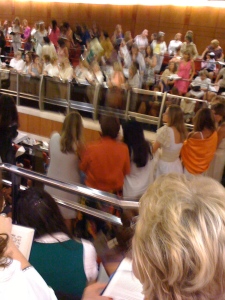Iom Kipur
September 28, 2009
Around 5pm I went to the Lebovitch synagogue a few blocks away from our house. I followed a few young women in through the nondescript outer wall, past a security booth and into a bright space filled with kids sitting on the steps, men in suits, men in jeans, and men with pais and talit strings falling below their white shirts talking on cell phones and chatting with one another. Little girls in smocked dresses whispered and giggled. I grabbed prayer book and went up the stairs to the women’s section. I couldn’t see below to where the men were chanting prayers that had been folded into my consciousness since I was small, but there was something so familiar about it. Standing against the wall I had a good vantage point of all of the women. Most were homely compared to most Brazilians.

There was one family of extremely beautiful blond girls, two daughters and two mothers, maybe all sisters, a few rows in front of me. In gorgeous creamy silk dresses, I couldn’t help but think this is what the Traiman women must have looked like at their shul. The woman directly in front of me was perfectly situated as a matriarch, a pillar of the community. Everyone who walked it double kissed her and wished her a shana tova. Many of the women stood with their shoes off, heels fallen next to their bare toes. Children wound in and out of the chairs, a baby fussed and then stopped. The women next to me asked how many pages we had until the end. When the rabbi or the hazan skipped a page she said, estao correndo, they’re running. Estao com fome, I replied. It was nice, warm, chaotic, a little loud. The dresses were, on the whole, much brighter, flashier, and more risque than the dour, or very expensive but quiet suits that fill the Westchester Jewish Center pews. I got in an Ashamnu, an Avinu Malkeinu and then the shofar blew and it was time to eat.